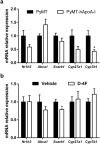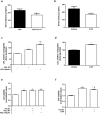ApoA-I mimetic administration, but not increased apoA-I-containing HDL, inhibits tumour growth in a mouse model of inherited breast cancer
- PMID: 27808249
- PMCID: PMC5093413
- DOI: 10.1038/srep36387
ApoA-I mimetic administration, but not increased apoA-I-containing HDL, inhibits tumour growth in a mouse model of inherited breast cancer
Abstract
Low levels of high-density lipoprotein cholesterol (HDLc) have been associated with breast cancer risk, but several epidemiologic studies have reported contradictory results with regard to the relationship between apolipoprotein (apo) A-I and breast cancer. We aimed to determine the effects of human apoA-I overexpression and administration of specific apoA-I mimetic peptide (D-4F) on tumour progression by using mammary tumour virus-polyoma middle T-antigen transgenic (PyMT) mice as a model of inherited breast cancer. Expression of human apoA-I in the mice did not affect tumour onset and growth in PyMT transgenic mice, despite an increase in the HDLc level. In contrast, D-4F treatment significantly increased tumour latency and inhibited the development of tumours. The effects of D-4F on tumour development were independent of 27-hydroxycholesterol. However, D-4F treatment reduced the plasma oxidized low-density lipoprotein (oxLDL) levels in mice and prevented oxLDL-mediated proliferative response in human breast adenocarcinoma MCF-7 cells. In conclusion, our study shows that D-4F, but not apoA-I-containing HDL, hinders tumour growth in mice with inherited breast cancer in association with a higher protection against LDL oxidative modification.
Figures





References
-
- Ferlay J. et al. Cancer incidence and mortality worldwide: Sources, methods and major patterns in GLOBOCAN 2012. Int. J. Cancer 136, E359–E386 (2015). - PubMed
-
- Jafri H., Alsheikh-Ali A. A. & Karas R. H. Baseline and on-treatment high-density lipoprotein cholesterol and the risk of cancer in randomized controlled trials of lipid-altering therapy. J. Am. Coll. Cardiol. 55, 2846–2854 (2010). - PubMed
-
- Flote V. G. et al. High-density lipoprotein-cholesterol, daily estradiol and progesterone, and mammographic density phenotypes in premenopausal women. Cancer Prev. Res. (Phila. Pa.) 8, 535–544 (2015). - PubMed
-
- Huang H.-L. et al. Biomarker discovery in breast cancer serum using 2-D differential gel electrophoresis/ MALDI-TOF/TOF and data validation by routine clinical assays. Electrophoresis 27, 1641–1650 (2006). - PubMed

